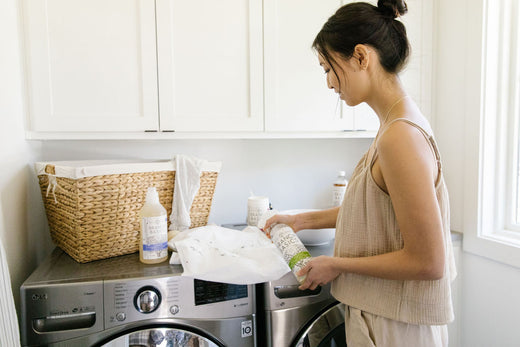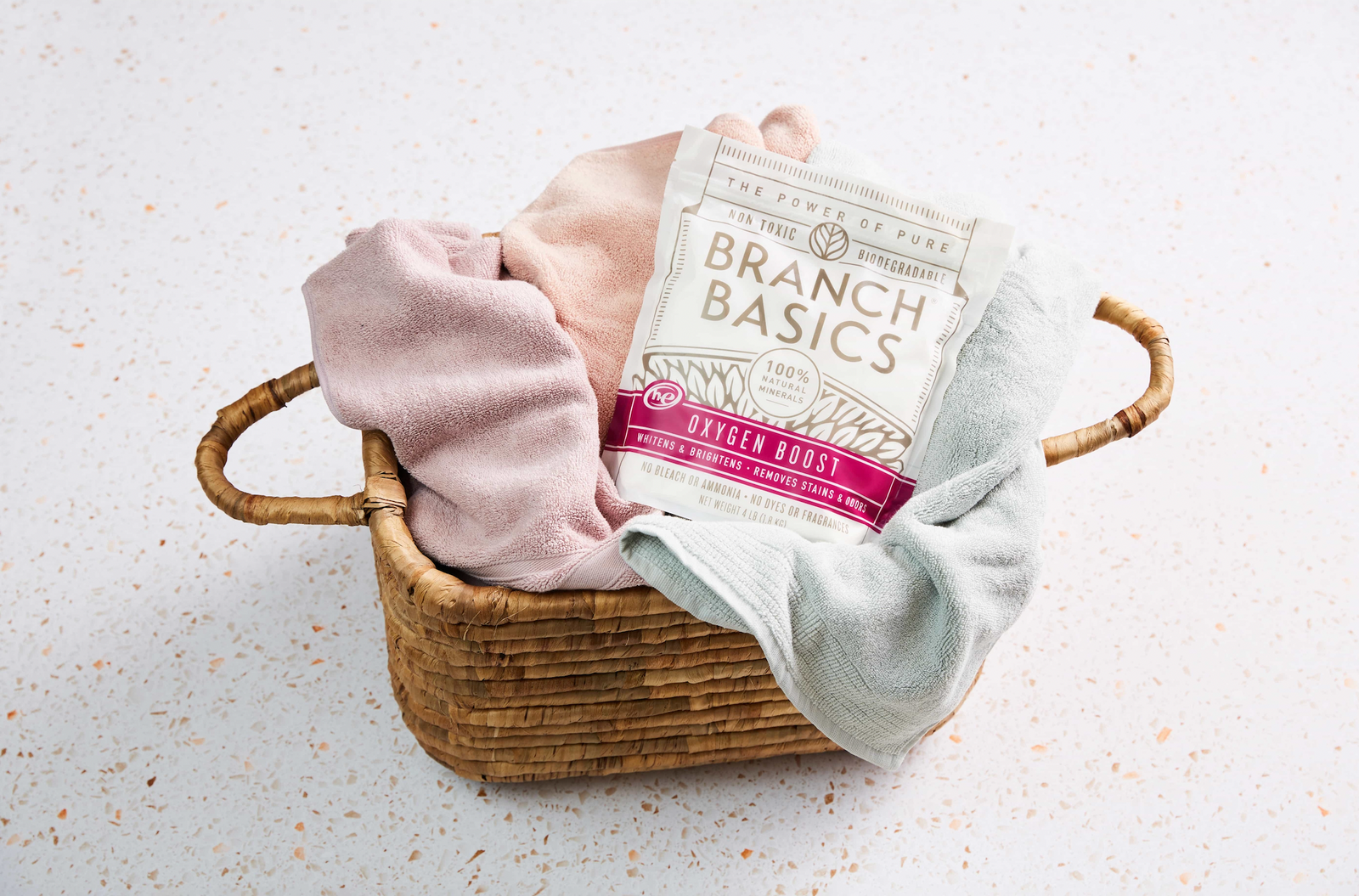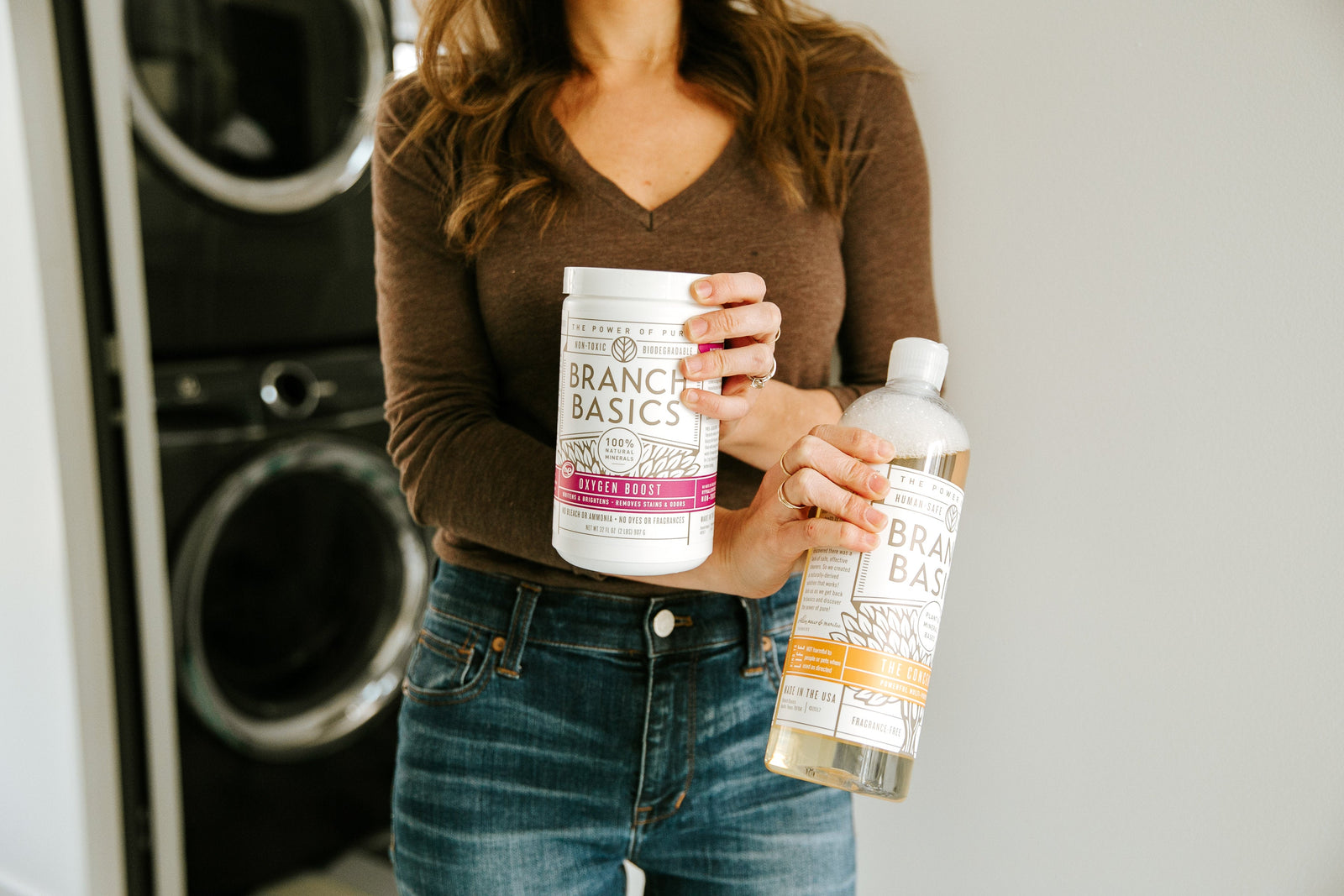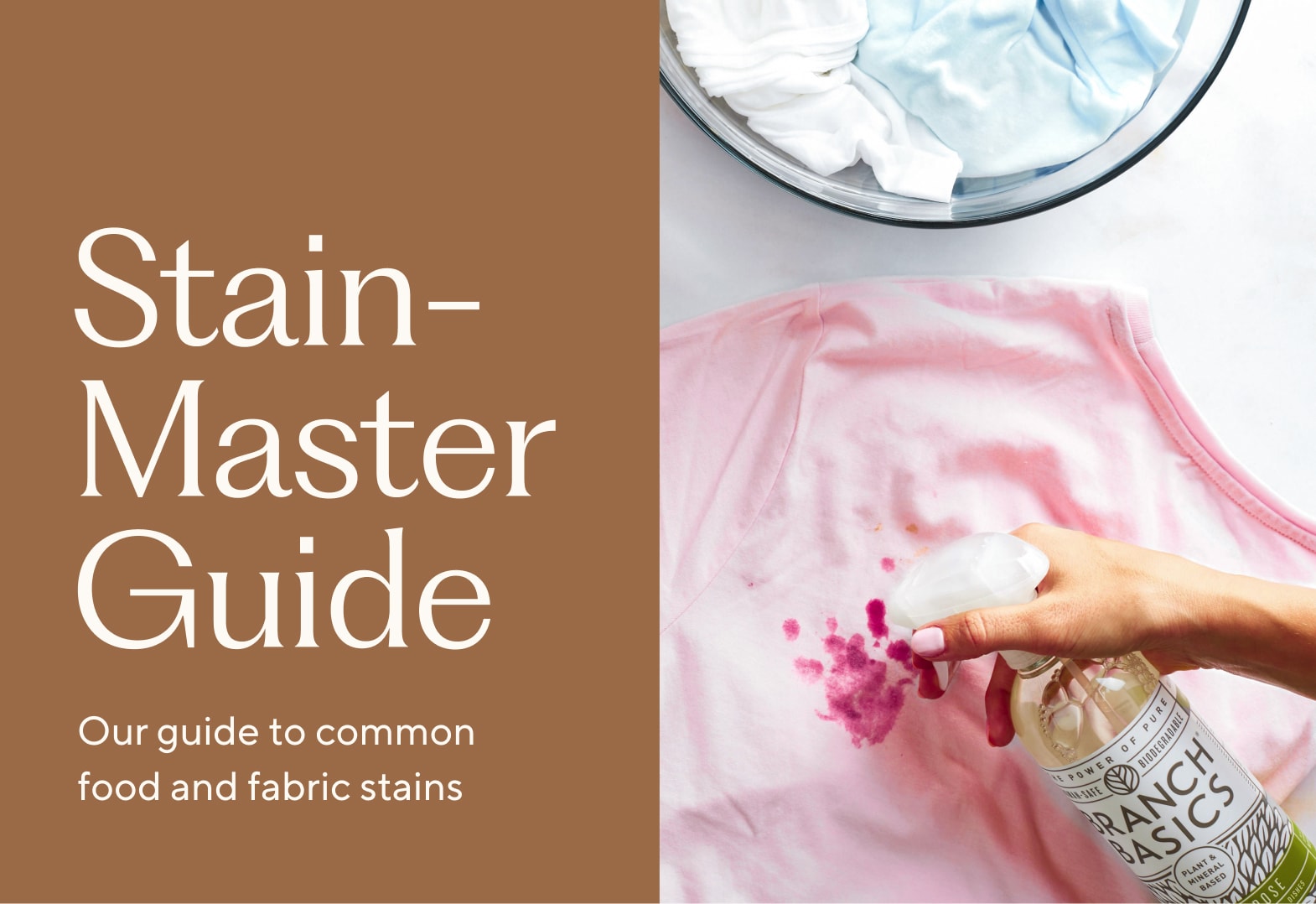How to Get Mold Out of Clothes Without Bleach

Whether you forgot to empty the washing machine before a weekend trip or accidentally stored your clothes in a damp location, mold happens. It’s important to understand how to remove mold, to avoid sickness that can be associated with mold exposure.
The question is: can you get mold out of clothes without using bleach?
For the situations described above, absolutely, yes! For clothing that has been contaminated by a mold-contaminated home, the solution can be more complicated and may require professional dry cleaning.
Read on for helpful tips on how to remove mold and mildew from clothing and fabrics using human-safe products.
1. Vinegar
Distilled white vinegar is an excellent spot treatment, soaking, and laundry agent for deodorizing and removing mold and mildew from clothing.
Note: I typically do not recommend using vinegar in foods or for cleaning to people suffering from mold exposure or Chronic Inflammatory Response Syndrome (CIRS). A cross sensitivity reaction to vinegar was experienced repeatedly by my clients and is being recognized now by physicians that treat mold exposed patients.
What You Need
- Distilled white vinegar
- A scrub brush
Steps to Follow
- Apply distilled white vinegar directly to the mold stain and let it dwell for at least an hour.
- Rinse and repeat if necessary.
- For larger stains, add 1 cup of distilled white vinegar to a basin or bowl and dilute with warm water.
- Soak the item for at least an hour, then launder for two cycles using the hottest cycle, adding an optional cup of vinegar to the washing machine plus your favorite natural laundry detergent.
Discover more ways to use vinegar for non-toxic cleaning and laundry in: 12 Ways to Use Vinegar in Your Home.
2. Hydrogen Peroxide
As previously mentioned, hydrogen peroxide is now recommended by the EPA and OSHA instead of bleach for mold remediation.
That’s because peroxide kills surface and subsurface mold, whereas bleach only kills surface mold while providing moisture for subsurface mold to thrive.
And it works great on light-colored clothing.
What You Need
- 3% Hydrogen Peroxide (in the brown bottle)
- Your favorite human-safe laundry soap
Steps to Follow
- Apply hydrogen peroxide directly to the mold stain(s).
- Let dwell for 10-15 minutes.
- Launder for two cycles using the hottest cycle, adding an optional cup of hydrogen peroxide to the washing machine plus your favorite human-safe laundry detergent.
Note: Hydrogen peroxide has a bleaching effect, so always test in an inconspicuous place first.
Peroxide should not be used on wool or silk.
Learn more about this inexpensive bleach alternative in: How To Use Hydrogen Peroxide As a Safer Alternative for Cleaning, Disinfecting, Laundry, & More.
3. Borax
Borax is an alkaline mineral that eliminates mold and mildew. Mold and mildew like acidic environments (pH of 2 - 7) and are not compatible with exposures to high pH. Since Borax has a high pH of 9.3, it is inhospitable to mold. It is not a dangerous disinfectant that kills through chemical action.
And bonus - Borax makes a great safe pesticide alternative due to its content of boron. While boron is an essential trace mineral needed in small amounts for the growth and maintenance of bone in humans, many insects are fatally sensitive to boron.
Note: Although it is a mineral, Borax is rated “5” on the EWG SkinDeep Database since Borax is toxic if ingested, and is a skin, eye, and lung irritant. Here is a well balanced article on safe Borax use, by Wellness Mama.
Note: Borax, like any powder, if inhaled, it a respirable fiber that can irritate the lungs. If you decide to use Borax and keep it in the home, be sure that you take care when pouring or applying the powder. Hold your breath when pouring the dry powder and do not use the powder form in the presence of children or anyone with lung conditions (COPD, asthma, bronchitis, etc.).
With safe practices, Borax can be used if clothing is contaminated with mold and/or if other methods have not worked.
Double rinse clothes washed in Borax as some people experience skin irritation from this product.
What You Need
- Borax
- Your favorite natural and human-safe laundry detergent
Steps to Follow
- Mix half a cup of Borax with warm water and add to your washing machine along with your favorite laundry detergent.
- Run on the hottest possible wash cycle and double-rinse clothing.
4. Natural Sunlight
Natural sunlight is an excellent mold killer and bleach alternative and complements any of these human-safe mold removal methods.
We like to use it:
- To dry out damp clothing before treating the mold
- To dry the treated clothing once it comes out of the washer
- For stubborn mold, use sunlight in between treatments to dry and natural bleach fabrics
5. Baking Soda for Extra Odor Removal
If there’s no more visible mold on your clothing, but it still smells musty, consider adding a cup of baking soda or Oxygen Boost (which contains baking soda) to the washer for an additional wash.
There are so many ways to use baking soda for non-toxic cleaning! Learn more in: Cleaning With Baking Soda (Sodium Bicarbonate): 12 Surprising Uses.
6. Branch Basics
Branch Basics was designed as an all-in-one human-safe cleaning system to replace every cleaner and laundry product in your home.
Here’s how to use Branch Basics Laundry plus Oxygen Boost to remove mold from clothing.
What You Need
In some cases, Branch Basics Laundry dilution plus a double hot water wash will not be enough to remove mold or mildew from clothing.
However, when you combine Branch Basics Laundry with the power of Oxygen Boost, it can work wonders on mold or mildew.
Our Oxygen Boost contains sodium percarbonate, also known as powdered peroxide.
This powder is activated by warm or hot water and will work like peroxide (which is now recommended instead of bleach by the EPA and OSHA for mold removal to kill mold and mildew.
Oxygen Boost also contains baking soda, which is a natural deodorizer.
What you’ll need:
-
Branch Basics Laundry Detergent or All Purpose
-
Oxygen Boost
Steps to Follow
-
Check the care instructions on the garment or fabric before beginning.
-
These products are generally safe for most fabrics, but Oxygen Boost should not be used on silks or wool.
-
Outdoors or in a well-ventilated area, spot-treat mold stains using either Branch Basics All-Purpose or Laundry dilution to remove as much of the mold as possible.
-
If you must treat the mold stain indoors, we recommend wearing a mask, closing off vents to prevent mold spores from becoming airborne, and ensuring the room is well-ventilated by opening a window and/or running an air purifier to avoid any issues with mold exposure.
-
Fill a basin or sink with hot water and add 1 scoop of Branch Basics Oxygen Boost.
-
Let garments soak for at least an hour or overnight. This will allow ample time for the powdered peroxide (sodium percarbonate) and baking soda in Oxygen Boost to kill the mold and mold spores.
-
Launder using the hottest water possible for two cycles with Branch Basics Laundry and an additional scoop of Oxygen Boost.
-
Hot water is essential for killing mold, so avoid the temptation to save energy this one time!
Repeat if needed (although it usually works the first time) until all the mold or mildew
Washing Machine Tips
In case we haven’t mentioned it enough, always use the hottest water cycle when washing moldy clothing. Hot water is critical to killing mold and mold spores.
But what if your washer was the source of the mold to begin with?
You can clean your washer and kill mold by using its self-clean function along with 1 cup of distilled white vinegar or hydrogen peroxide.
Plus, these safe and effective methods to get mold out of your clothing will also kill mold in your washing machine as you wash the garments.
To prevent mold and mildew in the washer:
- Clean the gasket with Branch Basics All Purpose to remove all dirt, grime, and mold.
- Spray down the gasket with hydrogen peroxide.
- Between washings, always leave the washing machine door open.
- Wash your washer monthly using hot water and 1 cup of distilled white vinegar.
For more tips on keeping your washing machine mold-free, check out: 5 Tips for Preventing Mold and Mildew in Your Front Loader.
How to Get Rid of Musty Smells in Your Closet
Closets can be tricky places to keep ventilated, especially if they’re in bathrooms or other areas that tend to be humid or damp.
Yet, it is vital to control humidity and keep your closets clean and dusted to prevent mold and musty smells.
Opening your closet doors for ventilation and/or using a dehumidifier if needed, are great options.
As is regular HEPA vacuuming of your closet and properly storing clothing for optimal air circulation.
If musty smells persist, it may be time for a more in-depth investigation.
Get more tips on removing musty smells from your closet and when to call in the pros in: How To Get Rid of Musty Smells Naturally.
Toss the Toxins (and the mold) With Branch Basics
Although there are many ways to toss the toxins to create a healthier home, the removal and replacement of chlorine bleach is one of our top recommendations.
You can read more about why in: Is Sodium Hypochlorite (Bleach) Toxic? The Dangers and Alternatives.
Branch Basics Concentrate (which can be made into All-Purpose, Bathroom, Streak-Free, Foaming Wash, Laundry soap and more) and Oxygen Boost are excellent options for replacing chlorine bleach for mold removal, laundry, and removing germs.
Check out our Starter Kits (available in plastic or glass) to discover how just one Concentrate plus Oxygen Boost can replace every cleaning and laundry product in your home.
Curious about more bleach-free alternatives for your home? Check out the following articles:

Marilee Nelson
Marilee Nelson is an Environmental Toxins expert who has spent nearly 30 years advocating for the chemically-sensitive and chronically-ill. She is a Board Certified Nutritionist, Certified Bau-Biologist and Bau-Biology Inspector and specializes in Food As Medicine. She has helped thousands of families and individuals identify, heal and recover from toxic exposures and is on a mission to revolutionize the way American families view their health.








